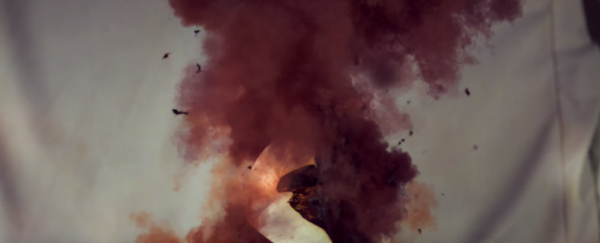We've all heard of nitroglycerin - that colourless, highly explosive liquid that you can detonate instantaneously with a hammer. And as we learnt from poor old Arzt the ill-fated science teacher in Lost, when used in dynamite sticks that have been left to rot in the middle of the jungle for god knows how long, it becomes incredibly unstable. But, as we discover in the video above by the UK's Royal Institution, a contact explosive called nitrogen triiodide takes this instability to a whole new level. Even a mosquito landing on it will send the whole thing up in (vibrant purple) smoke.
The reason nitrogen triiodide is so unstable is down to its molecular structure - one nitrogen atom and three iodine molecules all on one side due to how the nitrogen's electrons are arranged. And the problem with that structure is the iodine atoms are much bigger than the nitrogen atom, which means they're all squished up and constantly jostling each other for enough room. And all that repelling causes something called bond strain, which makes the entire molecule extremely unstable.
(At this point I'd like to give a shout-out to The Revenge of the 50-Ft Brain - the book you can see in the background of the video. I have no idea what it is, but from now on my life's regret is that I didn't write it. Also, that cover.)
One very noticeable characteristic of this incredibly unstable contact explosive is the awesome purple smoke it leaves behind as it detonates. The colour comes from the iodine molecules that fall apart when they detonate and reform again using a different arrangement. "It's this recombination that releases all of the energy, setting off more triiodide molecules, and more and more, in a chain reaction that races through the rest of the substance," the video explains. "Decomposing all of the molecules and releasing a huge amount of energy in a tiny fraction of a second."
Watch this process at an impressive 59,000 frames per second and you can see just how instantaneous this is. And if you're wondering how they were able to lay the nitrogen triiodide out in the first place without making it explode, the Royal Institution explains that you have to make it in a solution, and then leave it to dry out. While it's still wet, they say, the water stabilises the molecule, "then it's good to blow once it's dry".
If you can't get enough of contact explosives, don't worry, we've got you covered. Below you can watch the detonation of nitroglycerine slowed down more than 500 times, and it's glorious. And um, I don't know how to tell you this, but you've got some… Arzt… on you.
